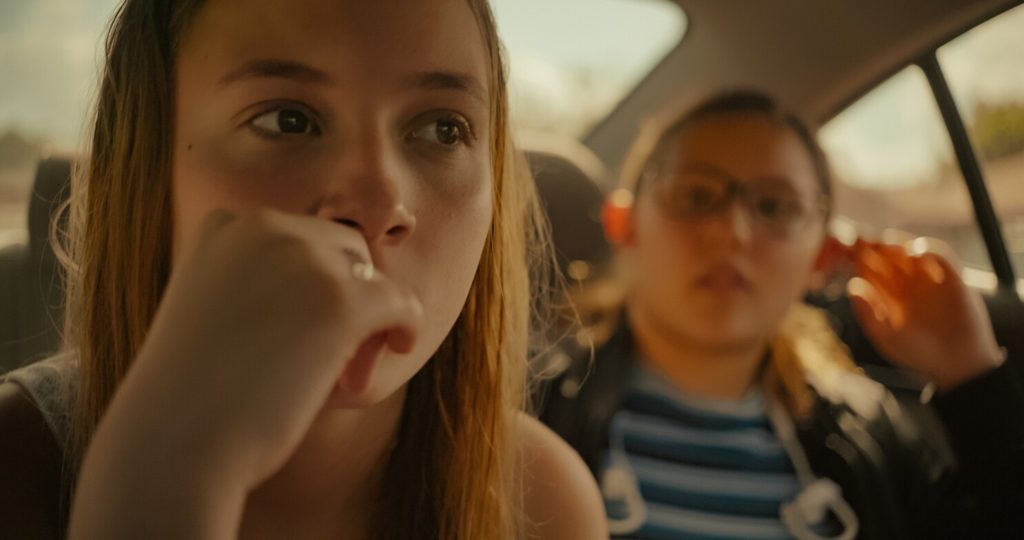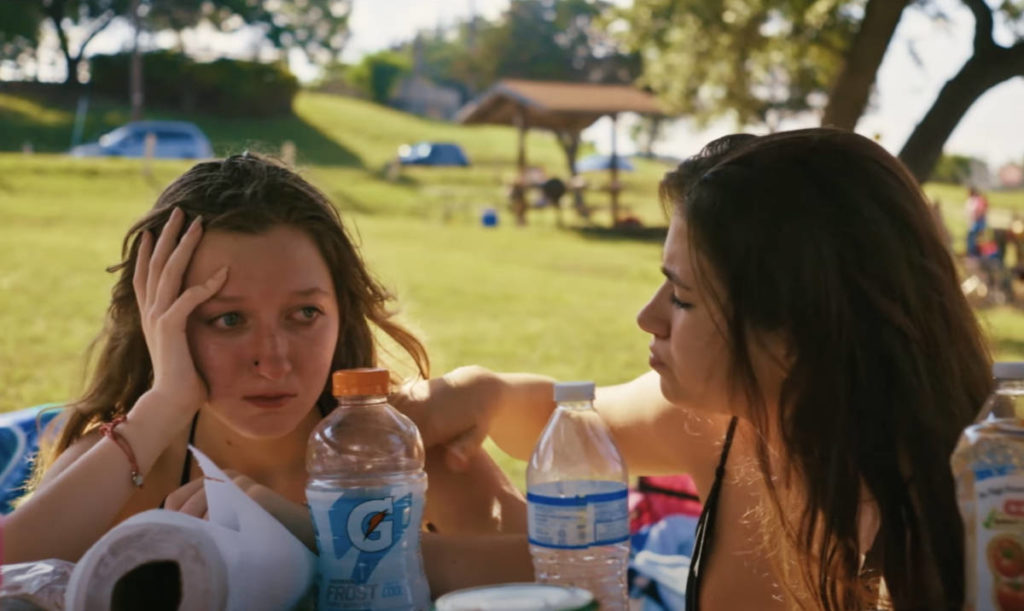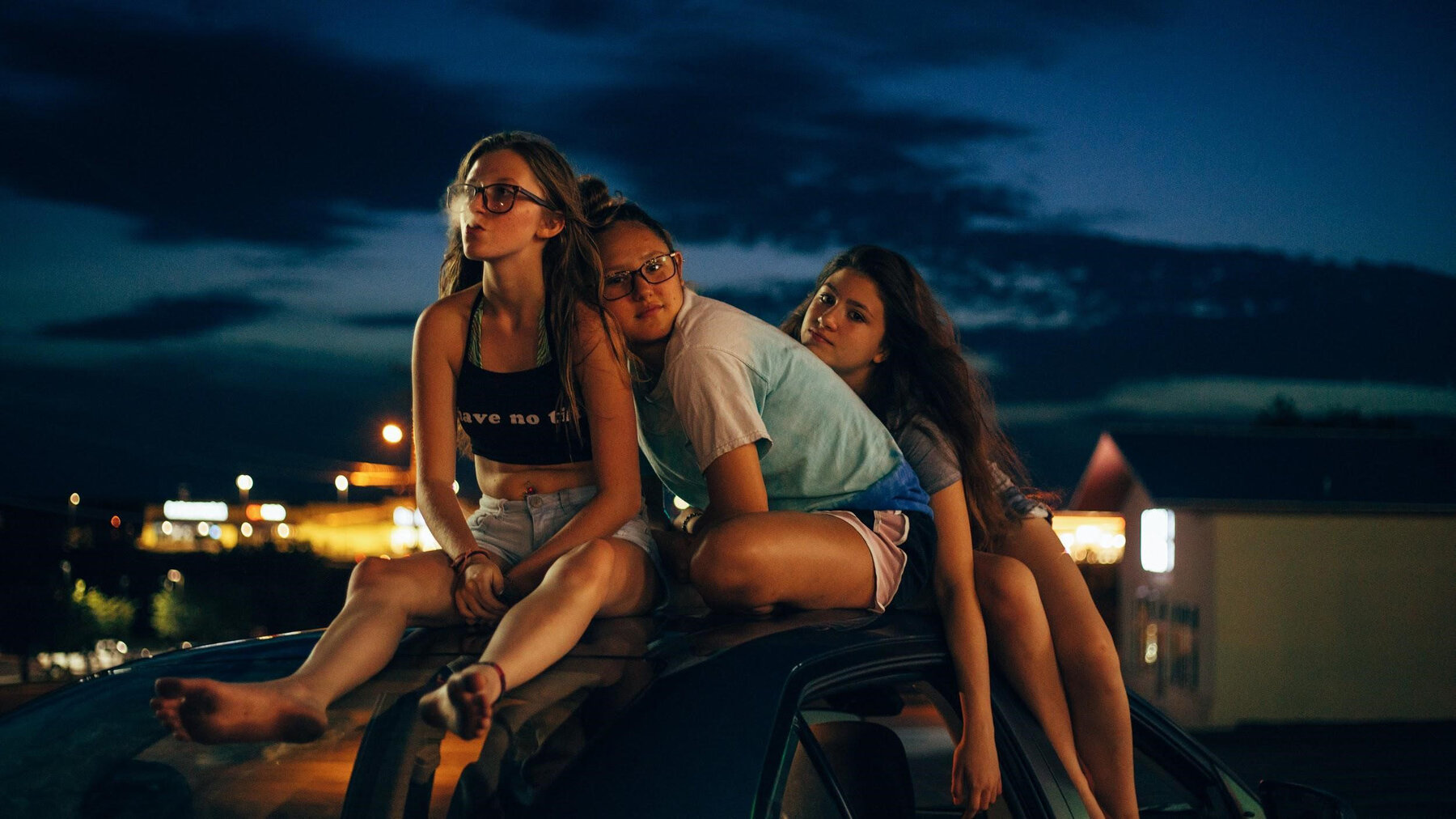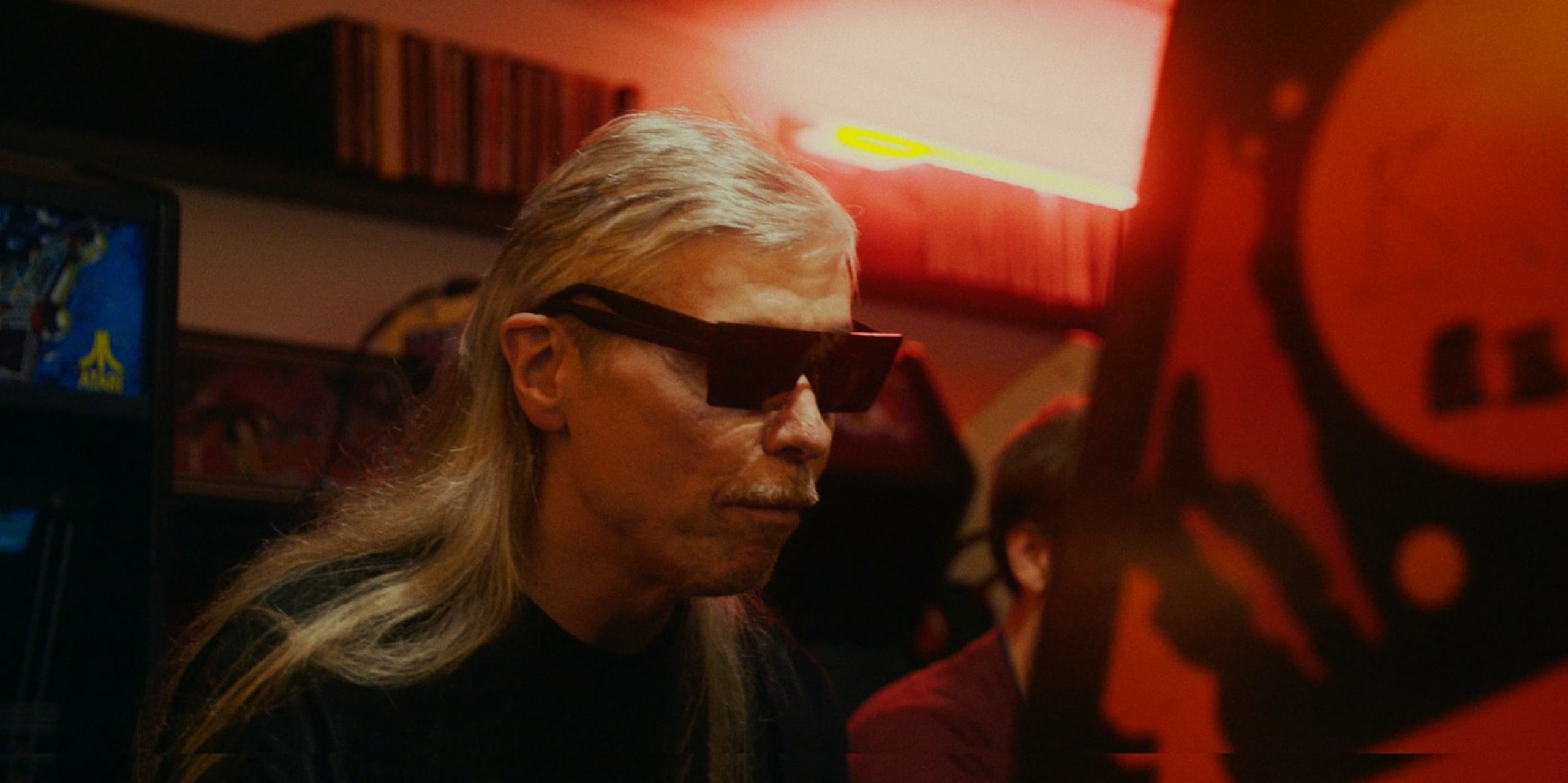“We really wanted to shoot these girls in way that makes other girls feel seen,” says Cusp director Parker Hill. Cusp, directed by Hill and Isabel Bethencourt, follows teens Aaloni, Autumn, and Brittany during one fateful summer in their small Texas town. Hill and Bethencourt capture the freewheeling energy of their subjects as they observe the girls doing what Gen Z girls do: hanging out while texting with other people on the phones, partying it up, and talking about boys.
On one hand, Cusp pulses with the optimism and vitality of youth as it relishes warm summer nights enjoyed with reckless abandon. On the other hand, the film is an intimate window into the pressures that young girls continue to face as society consent, sexual violence, and agency. Revelations of assault arise so casually that a viewer might not recognize them until a scene passes. The girls talk about rape in the same tones with which they discuss pizza toppings. It’s just something that happens. Cusp offers a portrait of the ongoing normalization of sexual violence and it observes how young women like Aaloni, Autumn, and Brittany adapt it into their daily language.
The film, which premiered at Sundance this year and won Bethencourt and Hill a special jury prize as emerging filmmakers, marks a notable debut for the two talents. Even though smartphones pepper nearly every frame, Hill and Bethencourt inject a timeless nature to the fleeting images of the girls’ lives. Magic hour cinematography gives Cusp a chance to breathe as Autumn, Brittney, and Aaloni embrace the fading hours of each day. As one day fades into another, Cusp suggests that every generation has its own struggles that are part of growing up.
POV spoke with Hill and Bethencourt by Zoom ahead of Cusp’s premiere on Showtime and Crave.
POV: Pat Mullen
IB: Isabel Bethencourt
PH: Parker Hill
This interview has been edited for brevity and clarity.
POV: Congrats on the film. I saw it at Sundance and enjoyed seeing it again.
PH: We changed it ever so slightly.
POV: What changed between Sundance and now?
PH: The biggest thing was the end of Brittany’s storyline and including a conversation that she had with her mother about her wanting to move out. It was something that we were always trying to make work. You want to tell every girl’s storyline as best you can and then see how these puzzle pieces fit together to tell a cohesive story. We were little pressed for time once we got into Sundance and were lucky to have everyone on board to spend a little more time finessing it after.
IB: We worked with a subject coordinator, which is sort of a new title. Her name was Souki Mehdaoui and she really helped us think about how we approached subjects of documentaries. We’ve never been in documentaries, so she helped us think about the conversation that we were going to have with them and helped us map out how to show a subject what’s in the film, what story they’re in, and how their lives are different from the characters in the film.
POV: What was the process of actually mapping out this story? I’ve read about how you met the girls when they literally rolled up to a gas station when you were parked there and the project started at that point. Were you shooting mostly on the fly depending on what they were doing daily?
PH: We would text them or they would text us being like, “What are you doing today?” We were up for whatever they were doing. If they were watching Grey’s Anatomy for four hours in their bedroom in the dark, even though there was a beautiful sunset outside or whatever, we were going to do it.
IB: A lot of the story comes about from spending so many hours with these girls and talking to them and listening to what they had to say. It comes from noticing things that they wanted to talk about and following those paths. The story grew organically as we got to know them.
POV: What sort of role did social media play in the production? They’re on Instagram and apps the whole time. Were you checking these things to learn more about what they weren’t telling you?
PH: In terms of the actual production, it was very helpful. They would post all the time. When we’d be at a party, they’d post “film crew’s back in town!” on Brittany’s Snap[chat]. People would reach out and want to hang out. In terms of the story, we did follow them on social to see what they posted and see if there’s a duality between who they are in person and who they’re not. We ended up not including it because it was probably only going to have been used for some of the characters and not for all of them. It would also date the film. A lot that we wanted to talk about feels timeless and less specific to the experience of posting.
People have this idea that you post a perfect version of yourself online and then you have other things going on. But we were struck by how, for some of these girls, it was actually the reverse. They were very open and vulnerable on social media and then hardened when we’d talk to them about certain topics in person. Once we started talking to them about that, we got some things organically on camera.
POV: They seem really natural and comfortable with the camera. Do you think it helps that they are always documenting themselves?
IB: I think it does help slightly. It’s funny because sometimes we’d be talking to them and in the middle of the conversation, they’d start making a Snapchat. They replaced a lot of text messages with videos of themselves speaking, which we had to get used to as young Millennials. It’s just so integrated into their lives. We’ve seen videos from school that are from six different angles. But it’s cool to see the ways that they take that and turn it into power and agency.
POV: How did you work with the pace and rhythm of their lives into the film?
PH: Something we really had to figure out was how to show their attention spans. They’re balls of energy that are moving and we’re trying to keep up with them and capture the story, but they will also talk about something very deep, and then ask for a Dr. Pepper and change the topic. Mid-conversation, someone will ask about someone else’s hair. They’re talking about so much and we really wanted the film to reflect that. Growing up, so much of what you’re experiencing, you’re experiencing for the first time. Teenage days are like dog years and they’re just growing so much.

POV: Were you struck by the casualness with which topics like sexual assault came up in conversations?
IB: We first met a larger friend group and were filming a much more observational short documentary looking at friend dynamics—boys and girls hanging out together and girls watching boys play video games. We were in the room just watching and observing and listening. When we got home and watched the footage, we realized that there was a lot more going on underneath the surface that you don’t immediately feel when you’re in the room. That kernel had us go back because you see how it does feel very, very normal in these rooms.
PH: There are dynamics at play. There’s so much going on in someone’s head that’s invisible.
IB: Especially in parts of the country. Teenage girls are not often looked at when it comes to coming of age stories. It’s easy to be invisible.
POV: How have things changed in the years since you were in high school in terms of the way people talk about consent? I think the midpoint between your high school experience and their high school experience would have been the explosion of #MeToo in 2017, so I was wondering if things are changing or if it’s really just the way people talk about consent that’s changing?
IB: I think certain things are changing. It depends where you’re from, but I think the work that’s been done is generally great. What we’ve noticed is that it’s maybe not going deep enough or is not comprehensive enough.
PH: These girls had never heard of #MeToo. We told them about it. They didn’t know what Time’s Up was or anything like that. It’s interesting and important to think about how progress isn’t progress everywhere and it’s not diminishing the work—we’re just getting started and breaking the surface of what’s going on. This is something that we obviously wanted to talk about here: if these girls are talking about things in such a normalized and casual way, there’s a reason. That means that things are happening that have made these things normal. We want people to confront that. #MeToo is obviously an incredible movement, but it hasn’t extended everywhere. There are girls in so many cities across the country, in the world, who are going through things like this and still need to feel comfortable and safe talking about it, speaking up, and knowing that they’re going to be listened to, and believed, and heard.

POV: What are some of the conversations that have come after the film? Have any of the boys who are mentioned taken accountability for their actions? Have you heard from any of the parents?
IB: The parents and the boys are slightly different. We have shown and offered to show the film to most of the boys in the movie—we’ve offered it to everyone. Some of them haven’t been able to watch it or didn’t watch it yet.
PH: I think it goes back to the idea that for something to be normalized, it’s really ingrained in so much of their culture. It’s ingrained in what they think and how they think. We didn’t necessarily make this film to confront or accost them or anything. It’s not accusatory. It’s just highlighting a dynamic and a status quo. Our intervention is making this film and hoping that people in the future can really talk about these things and hopefully change down the line.
POV: What was your approach for filming the parties?
IB: In making verité film, we wanted to show all the sides of their reality. It was important to show what parties are really like for them. It is what they’re experiencing and it does add to the story overall. Logistically, we never filmed anyone at parties if we didn’t have a release for them. But we already knew a lot of the boys and a lot of the boys were over 18, so they signed their own releases. The girls were usually 16-17, and the boys would be 18, 19 or 20.
PH: So much of our approach came in the edit as well. 90% of most parties are innocuous. Some of these party scenes are filmed across a couple of nights and stitched together to show the greater truth of the dynamics that are happening. Sometimes you’re at a party and you see something and you don’t linger on it. Your head moves and you go back to what you were doing. We really wanted to get into the headspace of what it feels like to be a girl in these spaces, hold on that, and pause and actually show their faces. They’re having fun until their face drops. Those moments are actually the most honest ones and they show if they’re scared, if they’re not enjoying themselves, if they’re trying to be cool, of it they don’t like this stuff. That is so much of the experience of what it is to be a girl and at these parties.
POV: Are there films or filmmakers you looked to for guidance?
IB: We watched Streetwise, by the photographer Mary Ellen Mark, Martin Bell, and Cheryl McCall. It follows kids living on the street in Seattle. It’s excellent.
PH: We looked at a lot of photography actually. That was some of our biggest inspiration for this film: women photographers who captured girlhood in a way that feels very relatable to us. Photographers like Lauren Greenfield and Melissa Ann Pinney. They happen to be in the same age range as our mothers and they photographed kids in the era when we were growing up. So many of their photos feel very accessible, like girls getting ready in front of a mirror with a colour scheme and the clothing that were relatable to us. They captured girlhood in a way that felt like, “I’ve had that moment before.” We really wanted to shoot these girls in way that makes girls feel seen.
POV: I’m actually glad you mentioned Lauren Greenfield because I’ve seen her films, and I know she does photography, but I haven’t really explored it beyond Generation Wealth.
IB: If you look up Girl Culture, that is the vibe that I’m referencing the most. There’s just a great humour too: there’s a kind of absurdity in youth with their antics and the way that they stand or hold themselves and hold things.
PH: Izzy’s style as a cinematographer is noticing people’s posture and details that are hilarious. The second you frame it, you’re like, “Oh my gosh, that’s a photo. That’s really funny.” The film has shots of two butts walking down the street in small jean shorts with giant phones in the pockets. The girls are trying to look older and they look ridiculous, but they’re loving it.
POV: One of the scenes that really stood out for me was the nipple-piercing scene. That’s obviously a situation I’ve never been in, but I was squirming and closing my eyes. What about that moment had an impact on you?
IB: I think especially towards the end of the film, you’ve been through a lot of heavy stuff with the girls. Even though there is levity and humour throughout, we wanted to end on a note of feeling like they have each other. They’re solving a problem; they’re going to be okay. They’re a bunch of teens in a room doing something stupid and we thought it was very indicative of the era and the age.
PH: At the end, Autumn says, “I feel like I just made a mistake.” We really wanted to highlight these moments. It’s a safe mistake considering what they go through. It felt like an innocent example of their adolescence. To be a girl is be in pain all the time. There’s so much eyebrow plucking and hair brushing. It was a very deliberate thing to talk about how the pain of being a girl is like an expectation.
Cusp premieres Nov. 26 on Showtime and Crave.













